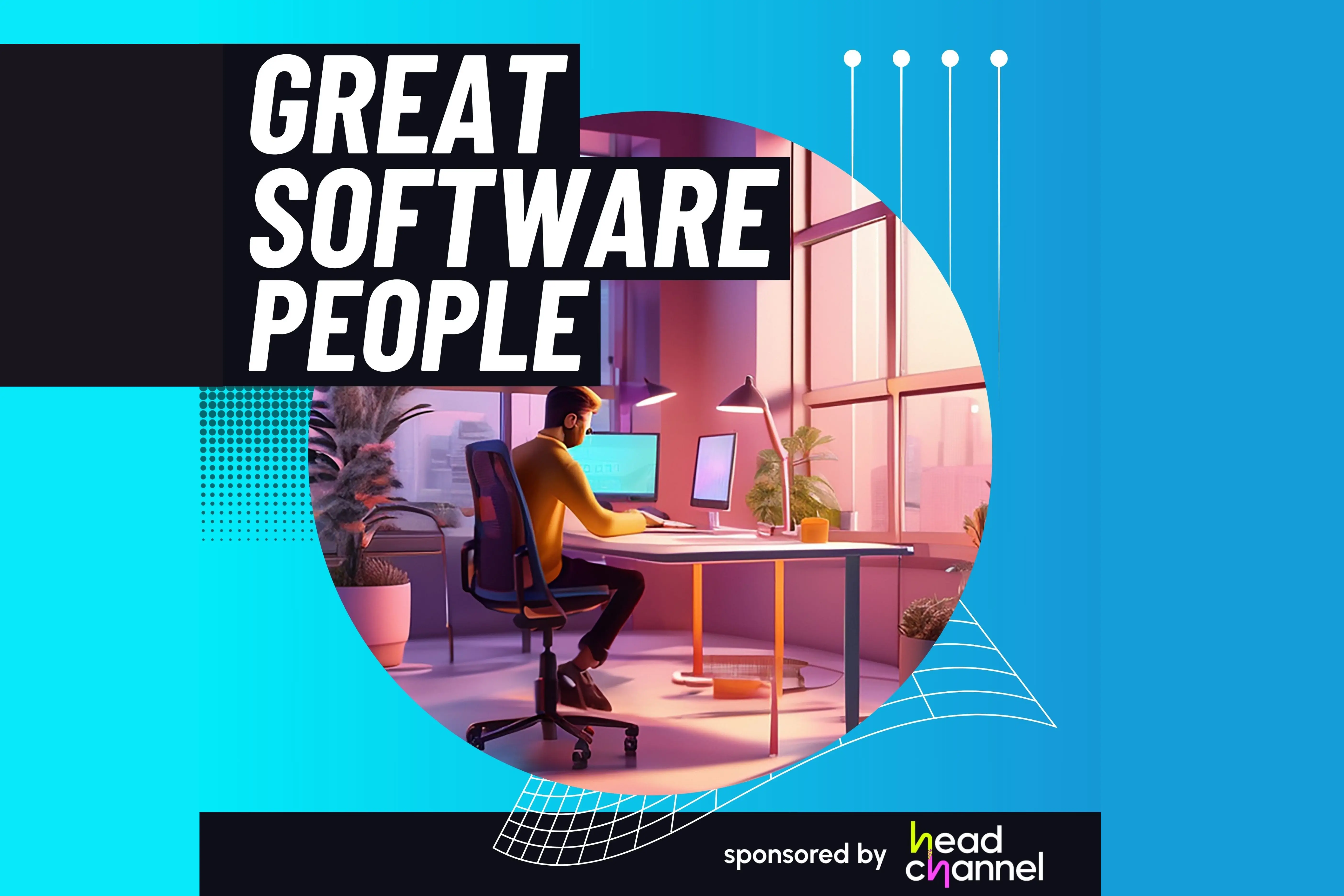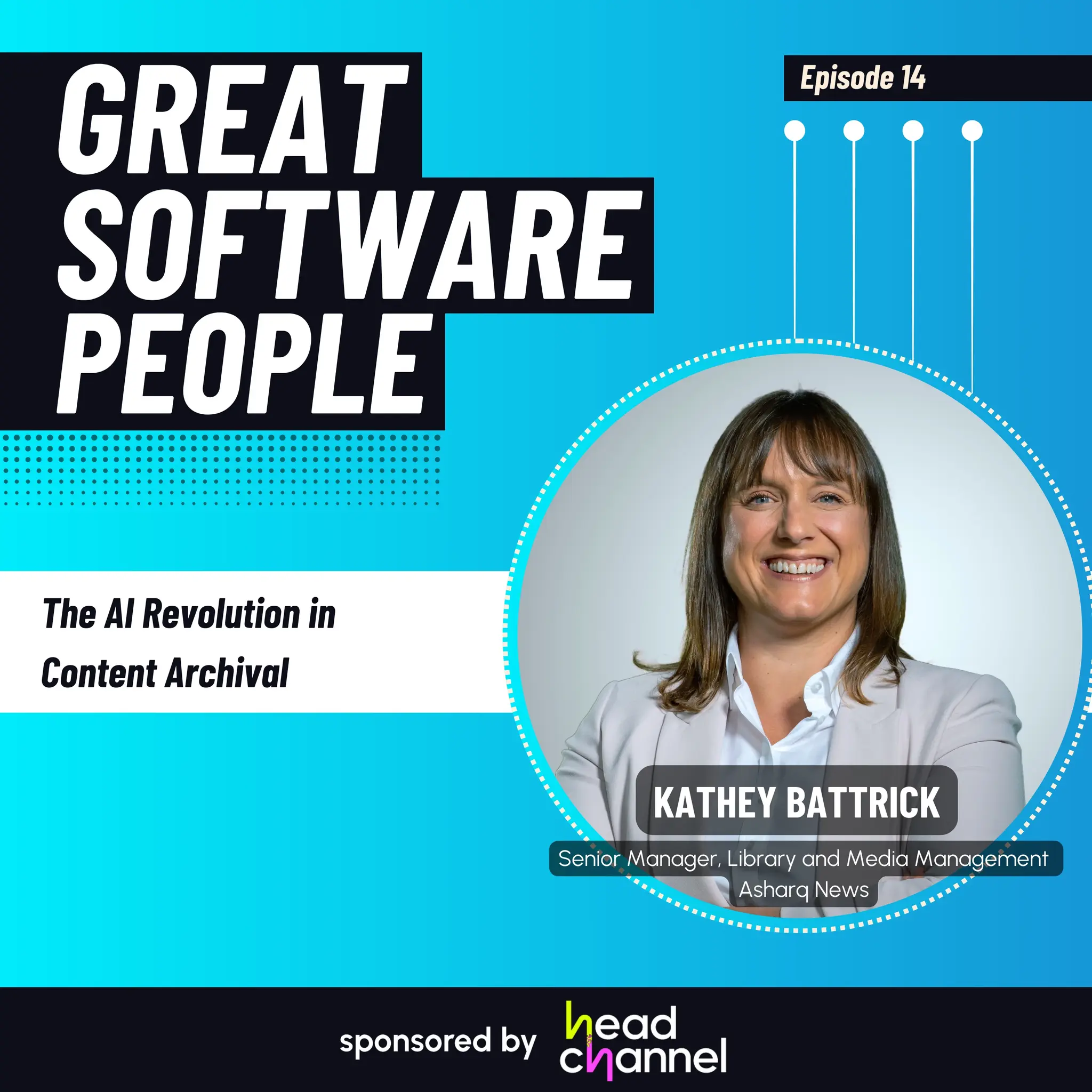
The AI Revolution in Content Archival with Senior Manager, Library and Media Management at Asharq News, Kathey Battrick - E14
Among the industries being touched by AI, there’s an undercover revolution in content archival that’ll change the future of journalism.
From her early start with British Pathe to her role as Senior Manager, Library and Media Management at Asharq News, Kathey Battrick has had a front row seat to watch media metadata evolve for the modern age.
Join us on Great Software People for a fascinating look into the future archival, content management, and its intersection with artificial intelligence.
This episode covers:
-
Kathey’s early roles, and how they became so formative to her current career
-
Developing custom software for content archival
-
AI’s role in creating multilingual metadata and facial recognition systems
-
Essential advice for software leaders with large teams

Episode highlights
“We were awarded a lottery grant to digitise the entire British Pathe archive, and at the time, it was the first fully digitised archive. I seem to recall the news making the New York Times - it was that groundbreaking project.” - 2:30 - Kathey Battrick
“If you’re a content licencing business and you have content but nobody can see it, you’re less likely to sell it at the end of the day. So our system really did open up additional revenue streams, and enable more efficient and effective repurposing of the content.” - 11:20 - Kathey Battrick
“One of our key challenges there was finding a dataset that recognised the people we need to recognise within our own content, which involves many Arab business leaders and public figures. We didn’t find one. So we’ve been creating our own.” - 16:00 - Kathey Battrick
“It’s important for all communication to be transparent, to give everybody a voice, to empower them and enable them to grow.” - 19:50 - Kathey Battrick
“AI is almost referred to as a magic quick fix that will resolve all of your metadata needs. It’s far from that. You need to understand what your business needs, and map those needs against AI processes.” - 21:25 - Kathey Battrick
LISTEN HERE:
[00:00:13]
Rich: Welcome to another episode of Great Software People! Today, I’m delighted to be joined by Kathey Battrick, Senior Manager of Library and Media Management at Asharq News. Welcome, Kathey!
Kathey: Thanks, Rich. I’m excited to be here and appreciate the invitation.
[00:00:43]
Rich: Let’s dive right in! I always ask my guests: when you were young and full of dreams, what did you want to be?
Kathey: I’ve been fascinated by technology from a young age. My dad had a Commodore 64, and I vividly remember watching him write lines of code—though at the time, I barely understood what he was doing. In school, I was lucky to have access to a custom-built IT unit, which was rare back then. But, funnily enough, my early career path was in veterinary science, not technology.
[00:01:40]
Rich: So, did you study veterinary science at university?
Kathey: I started by attending an agricultural college in Sussex, and I absolutely loved my time there. But before moving on to a degree, I took a year off, relocated to London, and unexpectedly found myself working in the archive and media technology world. That’s where I began my journey, starting with British Pathé.
[00:02:10]
Rich: British Pathé! That’s a name that sparks nostalgia for so many people. What was it like working there?
Kathey: It was amazing! We were awarded a lottery grant to digitise the entire British Pathé archive, making it the first fully digitised archive of its kind. The project even made the New York Times. I got to immerse myself in decades of history, from newsreels dating back to 1896 through the 1970s. It remains one of my favourite projects.
[00:02:53]
Rich: That must have been an incredible experience. How many newsreels did you end up digitising?
Kathey: If I recall correctly, it was about 6,000 hours of footage. All the film had to be meticulously prepared and transferred from tape to digital formats like Digibeta, and later to RAID storage.
[00:03:53]
Rich: So, after British Pathé, where did your career take you?
Kathey: I joined ITN in 2003, starting in the content licensing sales team before moving back into project management. My role was focused on ITN’s digital transformation. We implemented one of Europe’s largest Sony PetaSite systems at the time. By 2006, our archiving processes went completely tapeless, which was a huge milestone.
[00:04:38]
Rich: Tapeless archiving sounds revolutionary for that time. What were some of the challenges you faced?
Kathey: Initially, ITN’s archive consisted of both tape and film formats, with content dating back to 1955. We also managed the Reuters archive, which included early newsreels from the 1910s. Transitioning to digital required creating workflows to handle legacy formats alongside new, tapeless content.
[00:06:06]
Rich: Once everything was digitised, what happened to the original physical media?
Kathey: It depended on the condition of the asset. Some tapes and film reels were stored in specialised facilities, while others were deemed redundant and discarded after digitisation. For instance, we kept the ITN film archives in cold storage and only digitised broadcast-quality versions on demand.
[00:08:51]
Rich: What were some key milestones during your time at ITN?
Kathey: Digitising the ITN archive was a massive achievement, completed by 2011. In 2015, we partnered with Reuters to digitise their archive, resulting in over 100,000 digitised clips. The backbone of all this was the custom media asset management (MAM) system we developed in-house. External solutions didn’t meet our unique requirements, so we built a system that managed metadata, rights, and digital storage.
[00:09:28]
Rich: Was standardising metadata a big challenge?
Kathey: Absolutely! Over the years, different content sets had their own metadata schemas. Unifying them into a single, consistent schema was a monumental task, but it was crucial for efficient search and retrieval.
[00:13:44]
Rich: After ITN, where did your journey take you?
Kathey: My final ITN project involved delivering content workflows to Getty, which took over ITN’s clip sales. Afterward, I worked as a consultant, which led me to my current role at Asharq News. It’s a multi-platform Arabic news channel that launched in 2020. My main responsibility was setting up the library and media management department. One of our first big initiatives was integrating AI into our metadata creation processes.
[00:14:43]
Rich: AI in metadata creation—what a game-changer! What processes are you using AI for?
Kathey: We use AI for multilingual metadata creation, face detection and recognition, and summarisation. For example, we’ve trained our system to recognise 5,000 regional public figures, which makes it much easier for our newsroom to find soundbites and clips.
[00:16:40]
Rich: And what about generative AI? Are you using it?
Kathey: Yes, in three key areas:
-
Social Media Archival: We generate English titles for our Arabic social media videos to streamline the process.
-
Interview Summaries: AI creates summaries for the 70–90 interviews we archive daily.
-
Scene Descriptions: We’re starting to explore AI-generated scene descriptions to improve accessibility and searchability.
[00:19:02]
Rich: Managing large teams comes with its own challenges. What lessons have you learned over the years?
Kathey: Transparent communication is key, especially during restructuring or rationalisation. It’s also important to empower your team by giving them ownership of projects and opportunities for growth.
[00:20:15]
Rich: You recently published a paper on AI and metadata. Can you tell us about it?
Kathey: It’s called Indexing with Artificial Intelligence, and it offers practical advice for organisations considering AI for metadata creation. AI isn’t a magic fix—you need to understand your business needs and choose the right tools accordingly.
[00:22:26]
Rich: Where do you see the future of content archiving heading?
Kathey: AI will continue to enhance creativity and productivity, providing deeper insights into content usage and trends. Over time, AI will become as integral to the industry as the internet is today.
[00:24:00]
Rich: Do you think metadata itself will evolve?
Kathey: Definitely. I can imagine metadata expanding to include immersive, 3D spatial data for VR applications. Imagine being able to step into historical events through virtual recreations—that’s where we might be headed.
[00:27:03]
Rich: Thank you, Kathey, for sharing your incredible journey and insights. It’s been such a pleasure having you on Great Software People!
Kathey: Thank you, Rich. It’s been a lot of fun!

Contact us.
If you need a partner in software development, we're here to help you.
We will respond to your enquiry immediately.